| BR Standard Class 4 4-6-0 | |||||||||||||||||||||||||||||||||||||||||||||||||||||||||||
|---|---|---|---|---|---|---|---|---|---|---|---|---|---|---|---|---|---|---|---|---|---|---|---|---|---|---|---|---|---|---|---|---|---|---|---|---|---|---|---|---|---|---|---|---|---|---|---|---|---|---|---|---|---|---|---|---|---|---|---|
 A Standard 4MT 4-6-0 at Gloucester Eastgate in April 1959. | |||||||||||||||||||||||||||||||||||||||||||||||||||||||||||
| |||||||||||||||||||||||||||||||||||||||||||||||||||||||||||
| |||||||||||||||||||||||||||||||||||||||||||||||||||||||||||
| |||||||||||||||||||||||||||||||||||||||||||||||||||||||||||
| |||||||||||||||||||||||||||||||||||||||||||||||||||||||||||
The British Railways Standard Class 4 4-6-0 is a class of steam locomotives, 80 of which were built during the 1950s. Six have been preserved.
| BR Standard Class 4 4-6-0 | |||||||||||||||||||||||||||||||||||||||||||||||||||||||||||
|---|---|---|---|---|---|---|---|---|---|---|---|---|---|---|---|---|---|---|---|---|---|---|---|---|---|---|---|---|---|---|---|---|---|---|---|---|---|---|---|---|---|---|---|---|---|---|---|---|---|---|---|---|---|---|---|---|---|---|---|
 A Standard 4MT 4-6-0 at Gloucester Eastgate in April 1959. | |||||||||||||||||||||||||||||||||||||||||||||||||||||||||||
| |||||||||||||||||||||||||||||||||||||||||||||||||||||||||||
| |||||||||||||||||||||||||||||||||||||||||||||||||||||||||||
| |||||||||||||||||||||||||||||||||||||||||||||||||||||||||||
| |||||||||||||||||||||||||||||||||||||||||||||||||||||||||||
The British Railways Standard Class 4 4-6-0 is a class of steam locomotives, 80 of which were built during the 1950s. Six have been preserved.

The class was introduced in 1951. They were designed for mixed traffic use on secondary routes where the otherwise ubiquitous BR Standard Class 5 and their predecessors, the Black Fives, would be too heavy. They were essentially a tender version of the standard 4 2-6-4T, with similar characteristics to the GWR Manor Class, though unlike the Manors they were built to the universal loading gauge. They used the same running gear as the tank engine (with the leading bogie from the Standard Class 5), and substantially the same firebox, smokebox and boiler, although the boiler barrel was increased in length by 9 inches (229 mm). [1]
Design work was done at Brighton by R. A. Riddles, with help from Swindon, Derby and Doncaster. Construction was at the BR Swindon Works.
The engine weighed 67.90 long tons (68.99 t; 76.05 short tons), was 60 ft 0 in (18.29 m) long, with 5 ft 8 in (1.727 m) diameter driving wheels. It had two cylinders of 18 inches (457 mm) diameter and 28 inches (711 mm) stroke operated at maximum boiler pressure of 225 lbf/in2 (1.55 MPa), to produce 25,515 lbf (113.5 kN) tractive effort. Its British Railways power classification was 4MT.
It normally used the standard BR2 or BR2A tender, which weighed 42.15 long tons (42.83 t; 47.21 short tons) and carried 3,500 imp gal (16,000 L; 4,200 US gal) of water and 6.00 long tons (6.10 t; 6.72 short tons) of coal. In this configuration its route availability was 4, almost universal over the British Railways network.
The class was initially allocated to the London Midland Region (45) and the Western Region (20). The last 15 were allocated to the Southern Region. The Southern batch were built with BR1B tenders, which weighed 49.15 long tons (49.94 t; 55.05 short tons), and carried 4,725 imp gal (21,480 L; 5,674 US gal) of water and 7.00 long tons (7.11 t; 7.84 short tons) of coal. [2] This reduced their route availability to 7, the same as the Standard Class 5.
| Year | Quantity in service at start of year | Quantity withdrawn | Locomotive numbers |
|---|---|---|---|
| 1964 | 80 | 2 | 75001/67 |
| 1965 | 78 | 11 | 75000/03/05/07–08/22/25/28/38/72–73 |
| 1966 | 67 | 20 | 75011/14/23/31/36/44–45/49–51/53–54/56–57/63/65–66/69–70/79 |
| 1967 | 47 | 37 | 75002/04/06/10/12–13/15–18/24/26/29–30/33/35/37/39–40/42–43/46–47/52/55/58–61/64/68/71/74–78 |
| 1968 | 10 | 10 | 75009/19–21/27/32/34/41/48/62 |
Six members of the class survive with both single chimney and double chimney examples. Two were purchased directly from BR (75027 & 75029); the remaining four were rescued from Woodham Brothers' scrapyard at Barry Island.
No member of the class is presently main line approved but three (75014, 75029 and 75069) have worked on the main line at various points in preservation. 75029 was passed to work on the main line between Grosmont and Whitby with occasional visits to Battersby during galas. All except for 75079 have operated in preservation.
| Number & Name | Tender Attached | Chimney Fitted | Built | Withdrawn | Service life | Home Base | Owner | Livery | Status | Image | Notes |
|---|---|---|---|---|---|---|---|---|---|---|---|
| 75014 "Braveheart" | BR2A | Single | Nov 1951 | Dec 1966 | 15 years, 30 days | Dartmouth Steam Railway | Dartmouth Steam Railway | BR Lined Black, Early Emblem | Operational. Boiler ticket expires: 2026 [3] |  | |
| 75027 | May 1954 | Aug 1968 | 14 years, 3 months | Bluebell Railway | Bluebell Railway | BR Lined Green, Late Crest | Static Display [4] |  | |||
| 75029 "The Green Knight" | Double | May 1954 | Aug 1967 | 13 years, 3 months | North Yorkshire Moors Railway | North Yorkshire Moors Railway | BR Lined Green, Late Crest | Under Overhaul. |  | Withdrawn in 2015 with cracks in firebox, overhaul commenced in 2018 [5] | |
| 75069 | BR1B | Sept 1955 | Sept 1966 | 11 years | Severn Valley Railway | 75069 Fund | BR Lined Black, Late Crest | Operational. Boiler ticket expires: 2028 [6] |  | ||
| 75078 | Jan 1956 | Jul 1966 | 10 years, 5 months | Keighley and Worth Valley Railway | The Standard 4 Locomotive Preservation Society | BR Lined Black, Late Crest | Operational. Boiler ticket expires: 2032 [7] |  | |||
| 75079 | Jan 1956 | Nov 1966 | 10 years, 10 months | Mid-Hants Railway | Mid-Hants Railway Preservation Society | N/A | Under restoration [8] |  |
Bachmann and Hornby have both recently released models of these engines in 00 gauge. Mainline Railways also released a OO gauge model of the Standard Class 4MT 4-6-0 in the 1970s, although this is no longer in production. In 1983, Mainline's model was reintroduced to their catalogue as locomotive 75033 in BR lined black. [9]

Under the Whyte notation for the classification of steam locomotives, 4-6-2 represents the wheel arrangement of four leading wheels on two axles, six powered and coupled driving wheels on three axles and two trailing wheels on one axle. The 4-6-2 locomotive became almost globally known as a Pacific type after a New Zealand locomotive that was shipped across the Pacific Ocean.

Under the Whyte notation for the classification of steam locomotives, 4-8-4 represents the wheel arrangement of four leading wheels on two axles, eight powered and coupled driving wheels on four axles and four trailing wheels on two axles. The type was first used by the Northern Pacific Railway, and initially named the Northern Pacific, but railfans and railroad employees have shortened the name since its introduction. It is most-commonly known as a Northern.
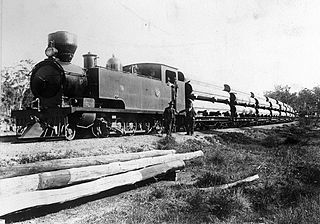
Under the Whyte notation, a 2-8-4 is a steam locomotive that has two unpowered leading wheels, followed by eight coupled and powered driving wheels, and four trailing wheels. This locomotive type is most often referred to as a Berkshire, though the Chesapeake and Ohio Railway used the name Kanawha for their 2-8-4s. In Europe, this wheel arrangement was mostly seen in mainline passenger express locomotives and, in certain countries, in tank locomotives.
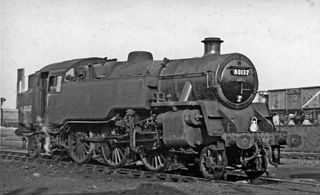
The British Railways Standard Class 4 tank is a class of steam locomotive, one of the BR standard classes built during the 1950s. They were used primarily on commuter and outer suburban services. They were capable of reaching speeds of 75 mph (121 km/h).

The BR Standard Class 2 2-6-0 is a class of steam locomotive, one of the British Railways Standard classes of the 1950s. They were physically the smallest of the Standard classes; 65 were built.

Under the Whyte notation for the classification of steam locomotives, a 2-6-4 locomotive has two leading wheels, six coupled driving wheels and four trailing wheels.

The London, Midland and Scottish Railway (LMS) Fairburn Tank 2-6-4T is a class of steam locomotive. They were designed by Charles E. Fairburn for the LMS. 277 of these locomotives were built between 1945 and 1951, numbered in the range 42050–42186, (4)2187–(4)2299, (4)2673–(4)2699.
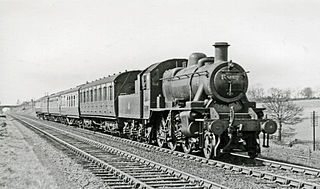
The London, Midland and Scottish Railway (LMS) Ivatt Class 2 2-6-0 is a class of steam locomotive designed for light mixed traffic.
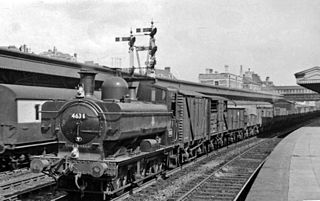
The GWR 5700 Class is a class of 0-6-0 pannier tank steam locomotive built by the Great Western Railway (GWR) and British Railways (BR) between 1929 and 1950. With 863 built, they were the most prolific class of the GWR, and one of the most numerous classes of British steam locomotive.
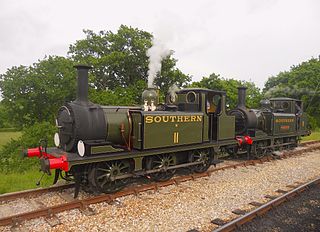
The London, Brighton and South Coast Railway (LB&SCR) A1 class is a class of British 0-6-0T steam locomotive. Designed by William Stroudley, 50 members of the class were built in 1872 and between 1874 and 1880, all at Brighton railway works. The class has received several nicknames, initially being known as "Rooters" by their south London crews. However, the engines were more famously known as "Terriers" on account of the distinctive 'bark' of the exhaust beat. Later in their careers, some engines were known as "Hayling Billy" on account of their work on the Hayling Island branch line. A pub of this name on the island was briefly home to the engine which is now No. W8 Freshwater.

The NZR B class of 1899 was a class of steam locomotives that operated on New Zealand's national rail network. An earlier B class of Double Fairlies had entered service in 1874, but as they had departed from the ownership of the New Zealand Railways (NZR) by the end of 1896, the B classification was free to be re-used. Despite early difficulties, they were amongst NZR's most influential designs.

The NCC Class WT is a class of 2-6-4T steam locomotives built by the Northern Counties Committee's parent company, the London, Midland and Scottish Railway for service in Northern Ireland.

The GS&WR Class 101, classified as Class 101 or Class J15 by the Great Southern Railways, was a class of 0-6-0 steam locomotives designed for working goods traffic although they did, and were quite capable of, working branch and secondary passenger trains.
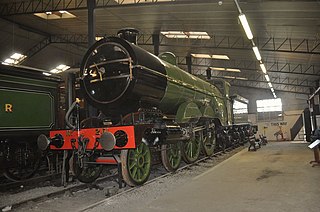
The Great Northern Railway (GNR) Class C1 is a type of 4-4-2 steam locomotive. One, ex GNR 251, later LNER 2800, survives in preservation. Much like their small boiler cousins, they were capable of reaching speeds of up to 90 mph (145 km/h). They were also known as Large Atlantics.

The London and North Eastern Railway (LNER) Thompson Class L1 was a class of 2-6-4T steam locomotives designed by Edward Thompson. The prototype no. 9000 was built in 1945, but the remaining 99 were built under British Railways jurisdiction between 1948–1950. The prototype was well received, however the production batch were not, and all were withdrawn and scrapped between 1960 and 1962.
Under the Whyte notation for the classification of steam locomotives by wheel arrangement, a 4-8-2+2-8-4 is a Garratt articulated locomotive consisting of a pair of 4-8-2 engine units back to back, with the boiler and cab suspended between them. The 4-8-2 wheel arrangement has four leading wheels on two axles, usually in a leading bogie, eight powered and coupled driving wheels on four axles and two trailing wheels on one axle, usually in a trailing truck. Since the 4-8-2 type is generally known as a Mountain, the corresponding Garratt type is usually known as a Double Mountain.

The South African Railways Class 23 4-8-2 was a class of South African steam locomotives.

The South African Railways Class 14A 4-8-2 of 1914 was a steam locomotive.

The South African Railways Class 12 4-8-2 of 1912 was a steam locomotive.